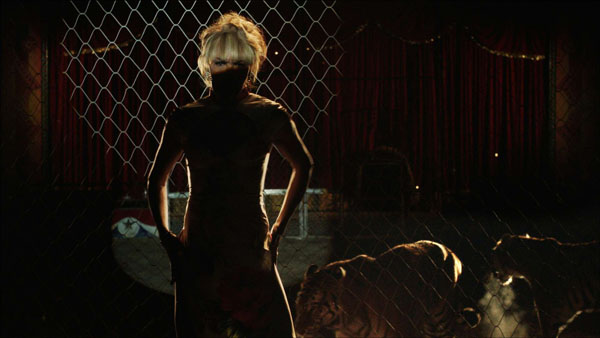As noted last week, João Pedro Rodrigues and João Rui Guerra da Mata will be at New York’s Film Society of Lincoln Center on Monday for a presentation of shorts they’ve made together and individually. The evening program’s got a title, Beyond Macao, a reference to their 2012 feature, The Last Time I Saw Macao, opening today for a week-long run at the FSLC. Meantime, Rodrigues’s new 30-minute film, The King’s Body, has just seen its North American premiere in Toronto.
So first up, The Last Time I Saw Macao, “a deeply alluring contemplation of Macao as reality and myth,” as Jonathan Romney puts it for Film Comment, “an investigation of the locale’s past, present, and future; and a fascinating experiment in form, combining visual essay in the ‘city symphony’ vein, personal search for a lost past, and self-consciously glamorous mock-thriller.”
At Slant, Jaime N. Christley suggests that “Macao owes a more crucial debt to Mariano Llinás’s 245-minute masterpiece, Extraordinary Stories, than to Rodrigues’s own reputation as Portugal’s premiere queer auteur. The new film, a noir-documentary whatzit that renders almost all of its characters in off-screen space, begins with an extravagantly lit lip-sync performance by transvestite Cindy Scrash. You think you know where you are, but the filmmakers pull the rug out almost immediately. Following the delicious cold open, the story shifts gears to a paintball battle that provides a clue as to the filmmakers’ use of negative space: There’s no paint, and spatial disorientation skitters across the red line as it did in the bank heist in Bresson’s L’Argent. Under the noisy war games, a real murder is committed, as an unseen gunman takes out an invisible target. We only have a close-up of the weapon and the victim’s dying rasp to tell us that something is amiss, and the death sets in motion a sort of dime-novel crime picture—stranger in a foreign city, in too deep—that has its roots in pulp fiction stories and films of the 1940s and ’50s. The touchstone is, of course, Howard Hughes’s Macao: Scrash’s song is taken from the 1952 film, where it was sung by Jane Russell, and The Last Time I Saw Macao‘s minimal story borrows from the abortive Sternberg picture’s equally minimal noir tropes, namely the one about ‘Leave Macao if you know what’s good for you.'”
In the New York Times, Manohla Dargis finds Macao to be “a sly, amusing if underconceptualized and needlessly elliptical inquiry into truth, memory and appearances.” Max Nelson, writing for Reverse Shot, proposes that it might be seen as an “extended lip-synch: our protagonist mouthing along to the strains of a past from which he’s long estranged, and an essay-film imitating a noir.” For Nick Schager at the AV Club, Macao is “often haunting, and its portentous and mournful atmospherics ultimately help compensate for the nagging impression that it’s a work almost too personal for an outside viewer to fully penetrate.”
“Through films like Two Drifters and To Die Like a Man, Rodrigues has shown himself to be one of the world’s most talented LGBT directors, as well as a worthy peer of Portuguese filmmakers like [Miguel] Gomes and Pedro Costa,” writes Steve Erickson at Gay City News. “Until now, Guerra da Mata has only made shorts. The two directors’ partnership has worked wonders.”
“In The King’s Body,” writes Adam Cook for Cinema Scope, “João Pedro Rodrigues sets up a camera and a green screen and hires a multitude of large, muscled men who, before stepping in front of the lens, know nothing of the filmmaker’s intentions. With footage of the statue of Dom Afonso Henriques, Portugal’s first king, in the background, these men are asked to undress, read passages about the king aloud, and wield a sword—but the real fun begins when Rodrigues begins to quiz his subjects about the king and Portuguese history, often with humorous and endearing results. Beginning as an investigation into the collective memory of the past, it doesn’t take long for the film to become a portrait of the present as each of the men describe their lives, a fair number of which are affected by the economic crisis.”
“A rare misfire from one of the best contemporary filmmakers working today, The King’s Body is an austere conceptual work that adds up to quite a bit less than the sum of its parts,” finds Michael Sicinski in the Notebook. “While there is an impressive serialism to Rodrigues’ presentation of these men and their performances—this is not a narrative work in any respect—one gets the sense that once The King’s Body was conceived, its realization was something of an afterthought.”
Update, 9/14: “In many ways,” writes Melissa Anderson for Artforum, “The Last Time I Saw Macao is a subtle love story: one that conveys not only the closeness between its makers but also their deep affection for an undersung work from Hollywood’s golden age and the actress they’ve chosen to inhabit both the past and the present, the make-believe and the real. This enchanting film is also a paean to anamnesis itself, an act that proves that the only reliable quality of memory is its profound unreliability.”
Update, 9/17: “There’s an affectingly Warholian tinge to these micro-portraits of exotic dancers, bodybuilders, carpenters and teachers modeling with earnest cluelessness for Rodrigues,” writes Fernando F. Croce of The King’s Body in the Notebook, “and, at just over 30 minutes, the filmmaker’s queering joke on Portugal’s mythical body politic doesn’t wear out its welcome.”
Update, 9/19: Keith Uhlich in Time Out New York on Macao: “A Portuguese colony until 1999, the city is now practically a country all its own, with its own legal, monetary and immigration policies. Onto this alien metropolis (which the directors photograph like documentary observers from a distant future) is grafted a sci-fi–noir tale involving murderous gangsters, a tragic transvestite, a filmmaker consumed by nostalgia for his past, and an arcane secret society obsessed with surviving the coming apocalypse by morphing into animals. It’s a lot to pack into 85 minutes, and by the cheekily doom-laden end, there’s a slight sense that Guerra da Mata and Rodrigues’s reach has exceeded their grasp.”
Toronto 2013 Index. For news and tips throughout the day every day, follow @KeyframeDaily on Twitter and/or the RSS feed. Get Keyframe Daily in your inbox by signing in at fandor.com/daily.





